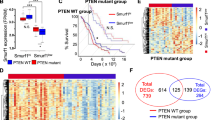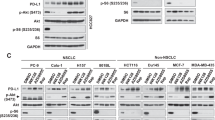Abstract
Rheb is a Ras family GTPase, which binds to and activates mammalian target of rapamycin complex 1 (mTORC1) when GTP loaded. Recently, cancer genome sequencing efforts have identified recurrent Rheb Tyr35Asn mutations in kidney and endometrial carcinoma. Here we show that Rheb-Y35N causes not only constitutive mTORC1 activation, but sustained activation of the MEK-ERK pathway in a TSC1/TSC2/TBC1D7 protein complex and mTORC1-independent manner, contributing to intrinsic resistance to rapamycin. Rheb-Y35N transforms NIH3T3 cells, resulting in aggressive tumor formation in xenograft nude mice, which could be suppressed by combined treatment with rapamycin and an extracellular signal-regulated kinase (ERK) inhibitor. Furthermore, Rheb-Y35N inhibits AMPKα activation in response to nutrient depletion or 5-aminoimidazole-4-carboxamide ribonucleotide (AICAR), leading to attenuated phosphorylation of BRAF-S729 and retained mitogen-activated protein kinase (MAPK) activation. Finally, we demonstrate that Rheb-WT can bind AMPK to facilitate AMPK activation, whereas Rheb-Y35N competitively binds AMPK, impairing AMPK phosphorylation. In summary, our findings indicate that Rheb-Y35N is a dominantly active tumor driver that activates both mTORC1 and MAPK to promote tumor growth, suggesting a combination of mTORC1 and MAPK inhibitors may be of therapeutic value in patients whose cancers sustain this mutation.
This is a preview of subscription content, access via your institution
Access options
Subscribe to this journal
Receive 50 print issues and online access
$259.00 per year
only $5.18 per issue
Buy this article
- Purchase on Springer Link
- Instant access to full article PDF
Prices may be subject to local taxes which are calculated during checkout






Similar content being viewed by others
References
Castro AF, Rebhun JF, Clark GJ, Quilliam LA . Rheb binds tuberous sclerosis complex 2 (TSC2) and promotes S6 kinase activation in a rapamycin- and farnesylation-dependent manner. J Biol Chem 2003; 278: 32493–32496.
Garami A, Zwartkruis FJ, Nobukuni T, Joaquin M, Roccio M, Stocker H et al. Insulin activation of Rheb, a mediator of mTOR/S6K/4E-BP signaling, is inhibited by TSC1 and 2. Mol Cell 2003; 11: 1457–1466.
Li Y, Inoki K, Guan KL . Biochemical and functional characterizations of small GTPase Rheb and TSC2 GAP activity. Mol Cell Biol 2004; 24: 7965–7975.
Long X, Lin Y, Ortiz-Vega S, Yonezawa K, Avruch J . Rheb binds and regulates the mTOR kinase. Curr Biol 2005; 15: 702–713.
Hay N, Sonenberg N . Upstream and downstream of mTOR. Genes Dev 2004; 18: 1926–1945.
Inoki K, Li Y, Xu T, Guan KL . Rheb GTPase is a direct target of TSC2 GAP activity and regulates mTOR signaling. Genes Dev 2003; 17: 1829–1834.
Laplante M, Sabatini DM . mTOR signaling in growth control and disease. Cell 2012; 149: 274–293.
Aspuria PJ, Tamanoi F . The Rheb family of GTP-binding proteins. Cell Signal 2004; 16: 1105–1112.
Sancak Y, Peterson TR, Shaul YD, Lindquist RA, Thoreen CC, Bar-Peled L et al. The Rag GTPases bind raptor and mediate amino acid signaling to mTORC1. Science (New York, NY) 2008; 320: 1496–1501.
Tabancay AP Jr, Gau CL, Machado IM, Uhlmann EJ, Gutmann DH, Guo L et al. Identification of dominant negative mutants of Rheb GTPase and their use to implicate the involvement of human Rheb in the activation of p70S6K. J Biol Chem 2003; 278: 39921–39930.
Ghosh AP, Marshall CB, Coric T, Shim EH, Kirkman R, Ballestas ME et al. Point mutations of the mTOR-RHEB pathway in renal cell carcinoma. Oncotarget 2015; 6: 17895–17910.
Saucedo LJ, Gao X, Chiarelli DA, Li L, Pan D, Edgar BA . Rheb promotes cell growth as a component of the insulin/TOR signalling network. Nat Cell Biol 2003; 5: 566–571.
Eom M, Han A, Yi SY, Shin JJ, Cui Y, Park KH . RHEB expression in fibroadenomas of the breast. Pathol Int 2008; 58: 226–232.
Goorden SM, Hoogeveen-Westerveld M, Cheng C, van Woerden GM, Mozaffari M, Post L et al. Rheb is essential for murine development. Mol Cell Biol 2011; 31: 1672–1678.
Lu ZH, Shvartsman MB, Lee AY, Shao JM, Murray MM, Kladney RD et al. Mammalian target of rapamycin activator RHEB is frequently overexpressed in human carcinomas and is critical and sufficient for skin epithelial carcinogenesis. Cancer Res 2010; 70: 3287–3298.
Lawrence MS, Stojanov P, Mermel CH, Robinson JT, Garraway LA, Golub TR et al. Discovery and saturation analysis of cancer genes across 21 tumour types. Nature 2014; 505: 495–501.
Grabiner BC, Nardi V, Birsoy K, Possemato R, Shen K, Sinha S et al. A diverse array of cancer-associated MTOR mutations are hyperactivating and can predict rapamycin sensitivity. Cancer Discov 2014; 4: 554–563.
Morris EJ, Jha S, Restaino CR, Dayananth P, Zhu H, Cooper A et al. Discovery of a novel ERK inhibitor with activity in models of acquired resistance to BRAF and MEK inhibitors. Cancer Discov 2013; 3: 742–750.
Holz MK, Blenis J . Identification of S6 kinase 1 as a novel mammalian target of rapamycin (mTOR)-phosphorylating kinase. J Biol Chem 2005; 280: 26089–26093.
Choudhary S, Wang HC . Proapoptotic ability of oncogenic H-Ras to facilitate apoptosis induced by histone deacetylase inhibitors in human cancer cells. Mol Cancer Ther 2007; 6: 1099–1111.
Lacher MD, Pincheira R, Zhu Z, Camoretti-Mercado B, Matli M, Warren RS et al. Rheb activates AMPK and reduces p27Kip1 levels in Tsc2-null cells via mTORC1-independent mechanisms: implications for cell proliferation and tumorigenesis. Oncogene 2010; 29: 6543–6556.
Im E, von Lintig FC, Chen J, Zhuang S, Qui W, Chowdhury S et al. Rheb is in a high activation state and inhibits B-Raf kinase in mammalian cells. Oncogene 2002; 21: 6356–6365.
Shen CH, Yuan P, Perez-Lorenzo R, Zhang Y, Lee SX, Ou Y et al. Phosphorylation of BRAF by AMPK impairs BRAF-KSR1 association and cell proliferation. Mol Cell 2013; 52: 161–172.
Kim SY, Jeong S, Jung E, Baik KH, Chang MH, Kim SA et al. AMP-activated protein kinase-alpha1 as an activating kinase of TGF-beta-activated kinase 1 has a key role in inflammatory signals. Cell Death Dis 2012; 3: e357.
Zheng B, Jeong JH, Asara JM, Yuan YY, Granter SR, Chin L et al. Oncogenic B-RAF negatively regulates the tumor suppressor LKB1 to promote melanoma cell proliferation. Mol Cell 2009; 33: 237–247.
Pierce BG, Hourai Y, Weng Z . Accelerating protein docking in ZDOCK using an advanced 3D convolution library. PLoS ONE 2011; 6: e24657.
Langendorf CG, Ngoei KR, Scott JW, Ling NX, Issa SM, Gorman MA et al. Structural basis of allosteric and synergistic activation of AMPK by furan-2-phosphonic derivative C2 binding. Nat Commun 2016; 7: 10912.
Lafourcade CA, Lin TV, Feliciano DM, Zhang L, Hsieh LS, Bordey A . Rheb activation in subventricular zone progenitors leads to heterotopia, ectopic neuronal differentiation, and rapamycin-sensitive olfactory micronodules and dendrite hypertrophy of newborn neurons. J Neurosci 2013; 33: 2419–2431.
Martin TD, Chen XW, Kaplan RE, Saltiel AR, Walker CL, Reiner DJ et al. Ral and Rheb GTPase activating proteins integrate mTOR and GTPase signaling in aging, autophagy, and tumor cell invasion. Mol Cell 2014; 53: 209–220.
Wang Y, Huang BP, Luciani DS, Wang X, Johnson JD, Proud CG . Rheb activates protein synthesis and growth in adult rat ventricular cardiomyocytes. J Mol Cell Cardiol 2008; 45: 812–820.
Zhou X, Ikenoue T, Chen X, Li L, Inoki K, Guan KL . Rheb controls misfolded protein metabolism by inhibiting aggresome formation and autophagy. Proc Natl Acad Sci USA 2009; 106: 8923–8928.
Hodges AK, Li S, Maynard J, Parry L, Braverman R, Cheadle JP et al. Pathological mutations in TSC1 and TSC2 disrupt the interaction between hamartin and tuberin. Hum Mol Genet 2001; 10: 2899–2905.
Jeon MT, Kim SR . Roles of Rheb(S16H) in substantia nigra pars compacta dopaminergic neurons. Biomed Rep 2015; 3: 137–140.
Yan L, Findlay GM, Jones R, Procter J, Cao Y, Lamb RF . Hyperactivation of mammalian target of rapamycin (mTOR) signaling by a gain-of-function mutant of the Rheb GTPase. J Biol Chem 2006; 281: 19793–19797.
Jiang H, Vogt PK . Constitutively active Rheb induces oncogenic transformation. Oncogene 2008; 27: 5729–5740.
Mavrakis KJ, Zhu H, Silva RL, Mills JR, Teruya-Feldstein J, Lowe SW et al. Tumorigenic activity and therapeutic inhibition of Rheb GTPase. Genes Dev 2008; 22: 2178–2188.
Mazhab-Jafari MT, Marshall CB, Ishiyama N, Ho J, Di Palma V, Stambolic V et al. An autoinhibited noncanonical mechanism of GTP hydrolysis by Rheb maintains mTORC1 homeostasis. Structure 2012; 20: 1528–1539.
Acknowledgements
This study was supported by NIH NCI 1P01CA120964. We thank Nathanael Gray, Heidi Greulich and John Blenis for the gift of reagents.
Author contributions
YW performed experiments and analyzed data. XFH, JW and YLY assisted with the immunoblotanalysis and in vivo mice experiment. YZ, ZL and LHZ designed and analyzed quantification proteomic data. YBZ and GHL performed the structural protein analysis. H-LP and GWX contribute to the experiment design and edits. YL and DJK designed and guided all experiments, interpreted data and wrote the manuscript.
Author information
Authors and Affiliations
Corresponding authors
Ethics declarations
Competing interests
The authors declare no conflict of interest.
Additional information
Supplementary Information accompanies this paper on the Oncogene website
Supplementary information
Rights and permissions
About this article
Cite this article
Wang, Y., Hong, X., Wang, J. et al. Inhibition of MAPK pathway is essential for suppressing Rheb-Y35N driven tumor growth. Oncogene 36, 756–765 (2017). https://doi.org/10.1038/onc.2016.246
Received:
Revised:
Accepted:
Published:
Issue Date:
DOI: https://doi.org/10.1038/onc.2016.246
This article is cited by
-
TSC-insensitive Rheb mutations induce oncogenic transformation through a combination of constitutively active mTORC1 signalling and proteome remodelling
Cellular and Molecular Life Sciences (2021)
-
An oncogenic mutant of RHEB, RHEB Y35N, exhibits an altered interaction with BRAF resulting in cancer transformation
BMC Cancer (2018)
-
Identification and profiling of growth-related microRNAs in Chinese perch (Siniperca chuatsi)
BMC Genomics (2017)



